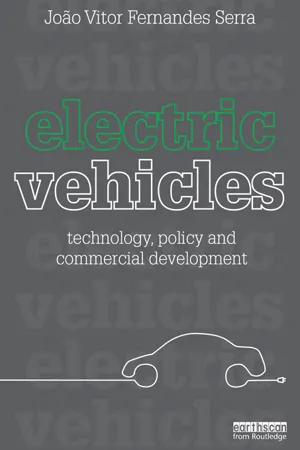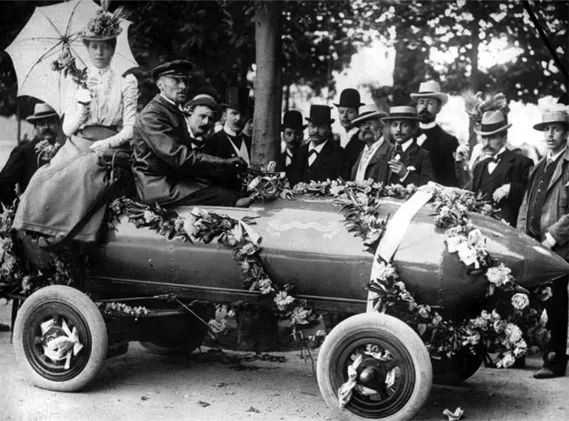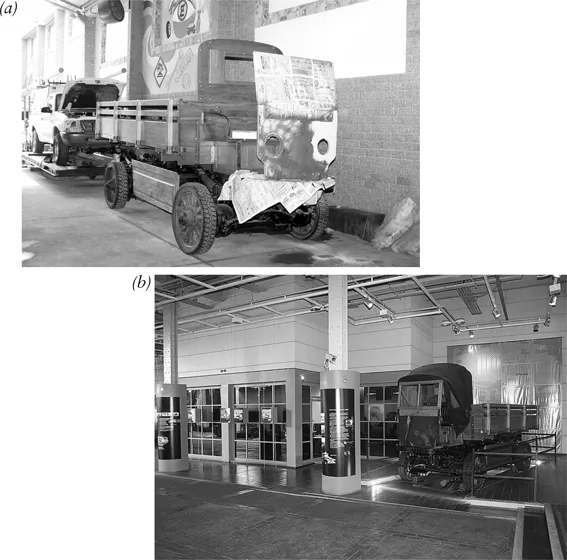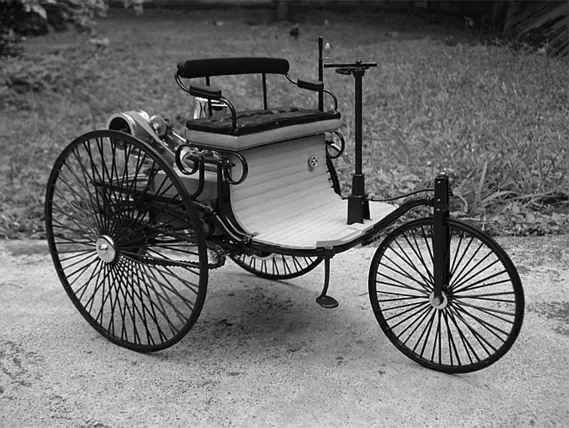![]()
Part I
Private Transport: Seizing the Initiative
![]()
1
How Combustion Beat Electric
Many of life’s failures are people who did not realize how close they were to success when they gave up.
Thomas Edison
Why is it that internal combustion engine vehicles (ICVs) became such a dominant technology while battery electric vehicles (BEVs), which were invented half a century before, failed to enjoy similar market success? Some of the most valuable lessons that history has to offer may often go unnoticed for some time due to the narrow interpretation of the constraints and opportunities we face at any given point. Perhaps our evaluation of ICVs and BEVs over the past half-century has been skewed, for instance, by a lack of understanding of the impact – on energy resources and the environment – that the ‘Western’ way of life and patterns of consumption have led to, as well as by an inability to imagine (and pursue) a future outside of prevailing standards.
Despite being an engineer, the author has a soft spot for history and believes that understanding why and how we arrived where we are provides an important basis to understanding what lies ahead. In this context, this book begins with a historical look at personal mobility, exploring how and why the ICV became the cornerstone of a mammoth automobile1 industry and for the last century has held an impermeable position as the dominant technology in that market. What dimensions were missed and left by the roadside during its impressive expansion? This chapter hopes to show that the changes that started to manifest themselves, in some cases, nearly 50 years ago have gradually accelerated and gained public visibility over recent decades, creating the conditions at the start of the new millennium for a paradigm shift – towards the era of the electric vehicle2 (EV).
The Rise of the Automobile
Urbanization, economic growth and the automobile
Since the Industrial Revolution, the world has experienced a dramatic change in the way human beings go about their daily lives. From jet planes and subways, to personal computers, cell phones and the internet, to refrigerators and espresso machines, mankind has witnessed a massive wave of technological advance and a corresponding increase in the rate of energy consumption over this period. In particular, the increased level of mobility offered by motorized transportation has revolutionized the spatial demographics of the industrialized world.
Prior to the Industrial Revolution, the size of human settlements was largely restricted to walking and horse-driven distances. However, with the introduction of motorized transport – in particular steam and electric trains and trams – urban boundaries expanded far afield along the corridors formed by public transportation links. The subsequent development of private transportation went a step further, allowing greater flexibility, beyond public transport corridors, for individuals. Urban areas began to expand in all directions, creating urban sprawl – of which the Randstad, the Eastern Corridor linking Boston and Washington, DC, and the São Paulo Metropolitan Area are just three examples (Figure 1.1).
Figure 1.1Urban sprawl
Source: Bill Rankin (2009)
Throughout the 20th century, economic growth in industrialized nations led to an accentuation in private transportation and automobile ownership, greatly accelerating urban sprawl. In turn, sprawl created a demand for access to ever more distant locations, which, as will be discussed, favoured the range advantages of ICVs for private transport. The growth of cities benefited from the mass-market version of the automobile while the automobile industry boomed with the growth of urban peripheries.
In fact, industrial society has become so dependent on the automobile that public transportation, while critically important to the functioning of cities, could be seen perhaps as a niche transportation market. Even in the case of Europe, public transit deteriorated at alarming rates in the closing decades of the 20th century. In England and Wales, for instance, the share of public transit trips dropped from 33 per cent in 1971 to 14 per cent in 1991 (Cervero, 1998). A similar trend can also be observed in the megacities of developing countries such as Buenos Aires (Argentina), Bangkok (Thailand) and Manila (Philippines).
Private transportation, the automobile industry and urbanization became mutually reinforcing symbols of modernity and progress in the 20th century. Indeed, one can hardly imagine a world without ICVs and the gas stations which service them. So how did this particular technology become such an intrinsic component of the modern way of life? Let’s look back at the origins of the automobile.
Innovators and early vehicle development
In 1801, Richard Trevithick, a Cornish mine manager, built the first steam-powered carriage (Figure 1.2) – also considered to be the first automobile or motor vehicle – giving way to the era of horseless transport. However, automobiles were not an immediate success. The steam engines that powered them were noisy and dirty and did not offer a significant improvement in performance relative to horse-driven transport.
Figure 1.2(a) Richard Trevithick and (b) his Steam Vehicle (1801)
Source: portrait by John Linnell (1792–1882)
The next major breakthrough in motor vehicle technology came in 1834, when Thomas Davenport, an American blacksmith and inventor, developed the first direct-current electric motor and used it to power model locomotives. In subsequent years, inventors developed an array of non-rechargeable battery-powered electric vehicles, including Robert Anderson’s BEV, which gave origin to the Detroit Electric (Figure 1.3). While such BEVs provided a more efficient, quieter, cleaner, and thus more desirable, method of transport than their steam-powered rival, they were significantly limited by dependence on non-rechargeable batteries.
Figure 1.3 Anderson’s Detroit Electric
Source: Asterion (Wikimedia Commons)
Four decades later, in 1865, Frenchman Gaston Planté (Figure 1.4) developed the first rechargeable lead-acid battery, causing a landslide of development. By 1884, the Electric Carriage & Wagon Company, founded by Morris and Salom, was producing the Electrobat, which was used as a delivery vehicle in Philadelphia and as a taxi in New York City. By 1886, Frank Sprague had developed the first electric trolley system (Figure 1.5) in Richmond, Virginia.
Figure 1.4 Gaston Planté
Source: Wikimedia Commons
Figure 1.5 Sprague’s Electric Trolley
Source: Wikimedia Commons
Founded in 1899, Baker Electric (Figure 1.6) became one of the leading automobile manufacturers in America, producing only BEVs for nearly two decades. And – guess what? – the classic American manufacturing icons, Oldsmobile and Studebaker, were formed in 1897 and 1902, respectively, to produce BEVs!
Figure 1.6 Three advertisements for Baker Electrics vehicles
Source: Alden Jewell (www.flickr.com/photos/autohistorian)
In Europe, the London Electric Cab Company was launched in 1897, operating 15 electric taxis in the British capital (Figure 1.7). That same year, regenerative braking (Chapter 4) was developed by M. A. Darracq, greatly improving the energy efficiency and range of BEVs. Bouquet, Garcin & Schivre, a French BEV and battery manufacturer founded in 1899, soon achieved a record range of 290 kilometres per charge. And – hold on to your seat! – on 1 May 1899, Camille Jenatzy drove his bullet-shaped creation (Figure 1.8) La Jamais Contente (‘The Never Satisfied’), to a world speed record of 110km/hr in Achères, France. Yes, the BEV was the first vehicle to break triple digit speeds.
Figure 1.7 London Electric Cab Company vehicle
Figure 1.8 La Jamais Contente
Source: Wikimedia Commons
The BEV success was far from limited to the Northern Hemisphere. In 1918, The Rio de Janeiro Tramway, Light and Power Company Ltd, commonly known as ‘Light’ by its customers, inaugurated a battery-powered electric bus service which operated in the capital’s downtown area. Local newspapers praised the clean and silent nature of the electric buses next to its ICV rivals.3 In fact, the public transportation system in Rio de Janeiro came to be dominated by electricity, both battery-powered buses and grid-connected trams, throughout the first half of the 20th century. Alas, the last electric buses dropped out of service in 1948, though a few tramlines remain in operation to this day. In 2007, the last electric truck from Light’s original fleet was restored and now stands proudly in the atrium of the company’s headquarters in downtown Rio de Janeiro (Figure 1.9).
Figure 1.9 The ‘Light’ electric bus of Rio de Janeiro, introduced in 1918, here seen (a) during and (b) after restoration
Source: LIGHT SA Photography Archive
So where was the ICV while all of this was happening? Well, to the surprise of most people, it was not until 1885, more than half a century after Davenport’s original BEV, that Karl Benz conceived the first ICV (Figure 1.10)! Interestingly, its success was not immediate – at least not among the well-to-do who could afford the early-era automobiles. Its noisy and polluting propulsion system was considered a major public disturbance. And, while modern vehicles start without hesitation, the early ICVs required the driver to put some muscle behind the vehicle’s crankshaft to get it started, thus excluding most women and the elderly as potential drivers. These consumers were drawn to the ease and safety of the early BEV.
Figure 1.10 Benz’s Patent Motorwagen
Source: Wikimedia Commons
However, the luxury of silent and clean transport came at a hefty price – BEVs were equivalent in price to a modern-day Rolls-Royce. No wonder they were the preferred method of transport amongst the wealthy elite but were shunned by the lower and middle classes. The automobile – of whatever type – had yet to penetrate the mass market.
Out of the 4200 vehicles sold in the US in 1900, 38 per cent were BEVs, only 22 per cent were ICVs, with the steam-powered carriage making up the rest. Steady sales brought BEV registrations in the country up to 34,000 units by 1912. However, three critical factors came together in the opening decades of the 20th century to put an end to the success the BEV had enjoyed up to then.
The first blow to the BEV was its limited range capabilities. Despite the 290km mark referred to above, battery technology remained underdeveloped. Many sources highlight how weak market penetration in Europe compared to the US should have provided the BEV industry with the first signs of the trouble ahead (Ehsani et al, 2004, p13). Indeed, the BEV enjoyed much of its early success in America, where paved roads were limited mostly to major urban areas, so an automobile’s range was not a significant constraint. The process of paving European roads was years ahead of the American context, thus accentuating the BEV’s range constraints as drivers covered greater intercity distances.
However, it was the introduction of Henry Ford’s Model T (Figure 1.11) that revolutionized the private transportation market, transforming the automobile from an elite product to a product for the masses. The Model T was first introduced to the market in 1909 at the ‘low’ price of US$850 (equivalent to US$20,120 in 2008 prices). In principle, Ford’s accomplishment was process-focused, as any vehicle could be mass-produced to reduce costs. However, the BEV’s battery, as will be discussed in Chapter 4, could not benefit from a similar reduction ...










